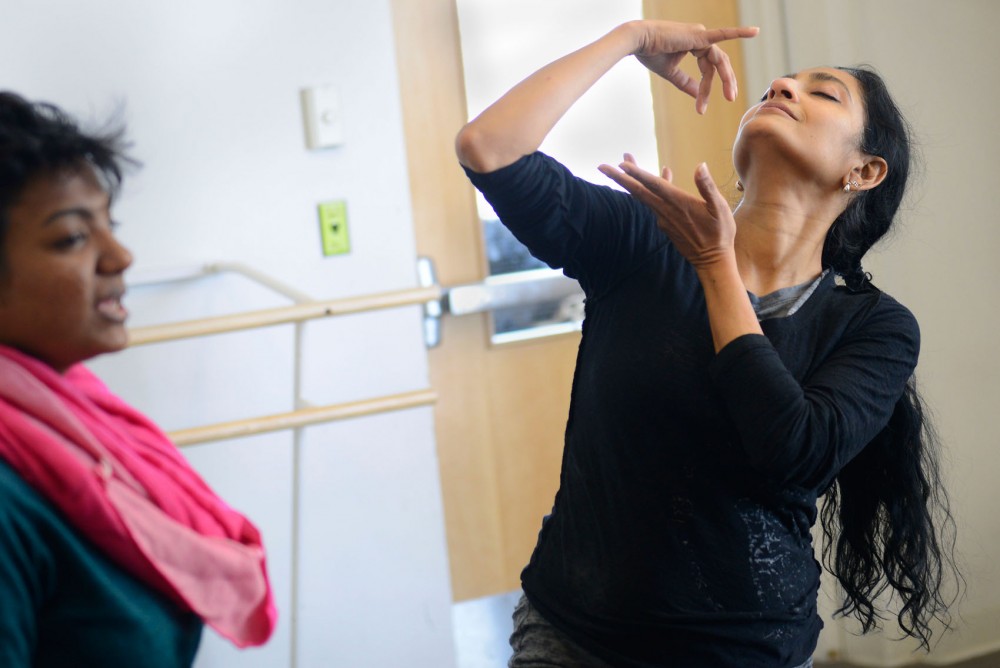The Ananya Dance Theatre’s performers moved with smooth precision on the top floor of the Barbara Barker Center for Dance on a cold Sunday morning.
Ananya Chatterjea, director of dance in the University of Minnesota’s Department of Theatre Arts and Dance, leads the company with attentive eyes. Though the dancers are focused on choreography, their work’s purpose is deeper than it may appear.
For its 10th anniversary, the dance company is now preparing a quintet of performances called “Work Women Do,” which explores the unacknowledged labor of women around the world.
Chitra Vairavan, the group’s principal dancer and rehearsal director, said their pieces aim to accomplish a mix of art and social justice activism.
“It’s such a radical notion what we are doing, so I find that it’s not feel-good work; it’s not entertainment,” she said. “So naturally there’s people that like it and people that don’t like, but it is a space that is needed.”
Chatterjea’s company has an unconventional creative process that encourages fluid communication, which allows for a collaborative style unlike most
unlike most professional companies, said Liz Ivkovich, a graduate student from the University of Utah.
Ivkovich studied the company as part of her research on dance forms that aren’t based on Western dance traditions. In her experience, she said, professional companies aren’t as welcoming and inclusive as Chatterjea’s.
“To me, that really speaks to the hard work that they do with community building, and this sense of each other and this sense of place and that they are able to include people in that,” Ivkovich said.
The company’s dancers echo that feeling.
“Being a new member, or apprentice, I’m seeing how much love is present in the room through freedom of laughter, or the freedom to cry, or the freedom to sit around and talk about our dreams and what brought us in and talk about our pasts,” said Leila Awadallah, a BFA dance sophomore and company apprentice.
Dance junior Kealoha Ferreira said society doesn’t always value knowing one’s body, which she said contributes to confusion about how dance can be activism.
Since its formation, the company has produced several pieces focusing on activism, including three performances inspired by environmental issues and a quartet of dances about systemic violence in global communities of color.
“It’s not just a discourse,” said Katie Haynes, a dance senior and Ananya Dance Theatre member for two years. “We are choreographing with the thought of expressing those ideas and discourses within social justice work and activism.”
A decade in the making
In 2004, Chatterjea announced an open invitation for women of color in the Twin Cities to go on strike from their work. About 40 women responded.
Chatterjea said the strike consisted of dance rehearsals that eventually became the Ananya Dance Theater’s original membership.
With no funding and few experienced dancers, Chatterjea used her expertise to train this group until it was performance-ready.
Soon after, those on strike began Ananya Dance Theatre. In 2005, her dance company had its first performance at the Southern Theater with “Bandh: A Meditation on Dream.”
Though the company was made up of inexperienced dancers a year earlier, the performance sold out.
“Women dream big dreams,” Chatterjea said. “Their dreams are huge, and they are changing the universe.”
But the company has changed since its first shows.
Although she wanted a company with 40 dancers, Chatterjea decided that wasn’t financially feasible.
In order for the Ananya Dance Theatre to survive, Chatterjea had to form a smaller company made up entirely of professional dancers.
“What I love about Ananya Dance Theatre is that they are very open about the process they take to create their work,” said Coya White Hat-Artichoker, a longtime supporter of the company.
Ananya Dance Theater tries to engage with the community in general and with each audience in particular. The company hosts audience empowerment workshops in which it gives the audience an inside look at its artistic process and approach.
“That’s another thing I really love about ADT: They are willing to create opportunities for their audience to understand their work,” White Hat-Artichoker said.








